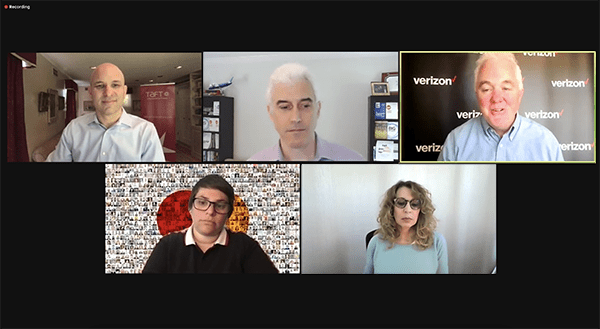
Today, “what’s the Risk of Inaction?” is replacing “what’s the Return on Investment?” in driving companies’ mindsets regarding their efforts around environmental sustainability. The result, a panel of experts observed at Taft Communications’ recent webinar, “Breathe it every day: Greening your company culture,” is helping to transform business’s view of its role in society to one that looks farther beyond the financial bottom line than ever before.
The panel featured corporate executives whose companies include more than 200,000 employees globally, and a leading author and thinker around companies’ role in driving sustainability.
In a poll taken among attendees during the webinar, 76.4% agreed or strongly agreed that their organization embeds environmental sustainability into the internal culture and the employee experience; 11.7% disagreed or strongly disagreed.
Click to tweet: Today, “what’s the Risk of Inaction?” is replacing “what’s the Return on Investment?” in driving companies’ mindsest regarding their efforts around #environmentalsustainability. Watch @Taftcomms recent webinar. http://ow.ly/2d5c50ELgN8 #companyculture
“The pressures on business have been rising for years and I think have accelerated in the last couple of years in particular,” said Andrew Winston, author of “Green to Gold” and founder of Winston Eco-Strategies. “More has changed in the last two years on the role of business in society, what it means to be a business, than in the 20 years before that I’ve been in this field… On the environmental side, truly existential threats forced us to change how we think. When you look at the costs and benefits, the calculus has changed.”
“Ten years ago, I wouldn’t have thought that it would ever be where it is,” observed James Gowen, senior vice president, global supply chain, and chief sustainability officer for Verizon.
What’s emerged is a corporate landscape where Mastercard creates networks for farmers in Kenya to connect to the digital economy and Bristol Myers Squibb gives employees an app to track their personal sustainability progress — just two examples that emerged from the expansive discussion about how companies seek to create an authentic culture of environmental sustainability that’s woven into the fabric of employee experience. Taft CEO Ted Deutsch moderated the panel.

As companies locate their purpose in the sustainability field, some common lessons are being learned:
- The workforce needs a strong voice at every step along the way. “We laid the groundwork very early, and that has led to building this into our DNA and into our culture,” said Victoria Emerick, global head of sustainability strategy and operations at Bristol Myers Squibb. “This is about employee alignment and driving to a common set of goals.” “It’s got to start and end with the employees,” Gowen added, “at every level of the organization.”
- There must be clear standards for setting and meeting goals. “Accountability is critical both in realizing the commitments you’ve made and being credible to your employees,” said Allison Kahn, vice president, people and culture communications at Mastercard.
- Clear, consistent communications — and not just to external audiences — are essential to maintaining momentum and employee engagement. “I think a lot of places tend to consider internal communications as an afterthought rather than from minute-one when you’re strategizing,” Kahn said. “And that means thinking about what are those components of any kind of external activation that you can adapt and roll out internally as well. And a recent fun example of that was around Earth Day. We ran a ‘plant it forward’ campaign externally on social media where we would match up to $200,000 for people to plant trees in honor of their friends, families, colleagues. And then, in parallel, we ran an internal campaign — three trees that every employee could gift forward to colleagues within the company. It’s a way to create awareness about the things we’re doing, but also to engage. It just deepens that culture of inclusion and camaraderie.”
Though the webinar focused on environmental sustainability, panelists made it clear that there are many connected issues where businesses are seeing a need to step up. A surge in interest in racial justice, for example, doesn’t mean companies should take their focus off sustainability. In fact, the issues are inextricably connected. Considering that the harshest environmental impacts around the world are felt by people in the most economically struggling areas, Winston said, “You can’t effectively address one area without looking at systems. Diverse voices in the board room and meeting room help people see how all things are connected.
“Listening, is how you build a culture of service,” he added. “A company that’s really going to create good in the world is going to be in service of stakeholders. They’re going to try to improve the wellbeing of their employees throughout their lives, help customers obviously, but also serve suppliers, serve the community, serve the governments that they’re trying to work with. If they start from that perspective, to serve, the profits and the benefits will come. That’s the crux of what we’re calling a net positive company… you have to be in service.”
Watch the recording of the webinar below:
Do you need to do more to put environmental sustainability at the core of your company culture but aren’t sure how? Get in touch to see how we can help.


